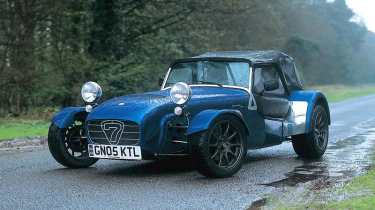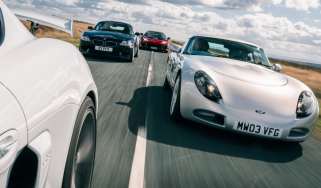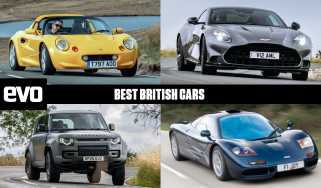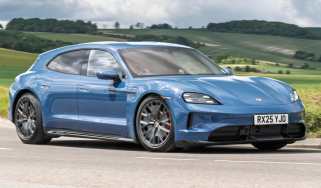Caterham Seven CSR 260: Reborn
We've had exclusive access to its development; now the re-engineered Seven hits the road
The new Caterham CSR sits in the paddock at Cadwell Park, glinting in late afternoon sunshine. It has taken over two years to get here, and it's been an interesting journey, peppered with twists and turns, highs and the odd low, the last twist being the surprise sale of Caterham to Corven Ventures three months ago. A lot has been crammed in since then to bring this part of the CSR program to fruition on time. The CSR represents the most dramatic re-working of the Seven concept in its near 50-year history, with major suspension, aerodynamic and interior revisions. While this CSR 260 is clearly a Seven, it's different in an intriguing way. Its dark blue paintwork plays down the aero changes - the flat-topped front wings, the radiator vent in the top of the nosecone, the small carbonfibre winglets on its sides and the chin-strap air-dam beneath, shaded by the front numberplate. From the rear it appears almost standard, except for the massive width of the new, bespoke rear tyres. What you can't see are the inboard spring/ damper units at the front and the new double-wishbone suspension at the rear, or the stiffening added to the tubular steel chassis to allow the suspension to work to maximum effect. Actually, that's not wholly true because the radical new dashboard with its swoopy frame of tubes is an integral part of the structure. We've followed this project from its inception in late 2002. We've sat in on meetings where the criteria for 'the most honed and focused Seven for the whole market' were thrashed out and where progress was assessed, watched the first prototype come together and attended the wind tunnel tests. The racecar prototype came first and we've driven it twice, late in 2003 when it was Rover K-series powered and late last year with the 256bhp (260PS) Cosworth Racing developed engine. That car was very impressive, immensely fast and wonderfully driveable, but of limited use as a pointer to how the road car would feel. This, then, is The Big Day. Caterham chose to launch the CSR at Cadwell Park, set in a fold in the Lincolnshire Wolds, but I'm here purely to drive the car on the road. The route that takes me home from here is among my favourites. The new facia and larger, dished Momo steering wheel give a new outlook but twist the key (or press the red button under the handbrake) and it sounds like business as usual. The all-alloy 2.3-litre Cosworth-tuned Ford in-line four is highly tuned and has a deep, burbling idle but proves much more tractable at low revs than I expected - it is far better mannered than, say, the 160bhp 1.8 K-series in our long-term R300. Set off and there's the familiar low-speed patter over bumps but after that the CSR moves swiftly to a whole new level of dynamic ability. It crept up on me, partly because the wider-bodied SV, starting point for the CSR, feels different to the regular Seven anyhow. It was the speedo that first alerted me to the performance of the chassis. I was mooching along, feeling my way in, when I looked down and found I was travelling a good 20mph faster than I felt I was. Where is the suspension fidget and the steering fight that have become accepted sensations when pressing on in a Seven? The CSR isn't even trying. I up the pace, the road gets more challenging, and I'm soon having the sort of revelatory experience that I did with the Elise a decade ago. The calmness of the CSR's progress over what I know to be difficult terrain is remarkable, and in absolute terms, not just compared with previous Sevens. It's as if this familiar road has been resurfaced. Indeed, the CSR is so composed that it feels as if the chassis of a larger sports car has been cunningly grafted under the lightweight, minimalist structure of the Seven. Snick down two gears, push the throttle to the stop and the CSR takes off with the pugnacious vigour you'd expect of a 565kg Seven with a torque-rich, 256bhp engine. It shoves you hard against the seat-back and sends shiver through the chassis and your bones as it climbs strongly into the manic zone beyond 5000rpm. This is one breathtakingly fast Seven, yet even when the Cossie engine is hollering loudly in the higher gears, the chassis remains relaxed and poised. There are some wicked undulations on these fen roads caused by subsidence, but they don't faze the chassis. Neither do sharp crests or punishing compressions, the CSR tackling them with a nonchalance that makes you wonder why there are so many sump-gouges scarring the asphalt. The CSR's steering plays an integral part in the composure of the new Seven. It has a different quality to other Caterhams; the wheel moves from lock to lock with an oiled precision, retains a linearity of weighting across a wide range of speeds and is slower geared (by 15 per cent) so that small inputs don't over-excite the chassis at high speed. At roundabout speeds I felt I wanted a little more response, to catch potential tail slides when goading the feisty, snappy engine. A bit more elbow room wouldn't go amiss, either; you sit low in the superb new Tillett carbon bucket, left elbow against the centre console, right against the fold-over latch of the sidescreen. As it turns out, you don't often have to grab opposite lock because traction is superb, even though no limited slip diff is fitted. If you should manage to unstick one of the broad, bespoke 245/40 Avon CR500s, the torque bleeds away harmlessly in wheelspin. In all, the dynamics of the CSR are remarkably well resolved. The set-up seems to have found twice as much suspension travel, controls wheel movement with measured precision, and has shifted the Seven's ability onto a much higher plane. It's a credit to all those involved, especially given the very tight schedule Caterham and its partners - Avon, Arch Motors and especially chassis engineering specialist Multimatic - had to work to at the conclusion of the project. When the dynamic objectives for the CSR were thrashed out in 2003, the Multimatic team identified the handling, ride and steering characteristics of a number of iconic performance cars, including Porsches, Ferraris and Aston Martins, as benchmarks. Back then, I couldn't imagine how the flyweight Seven could retain its essential character but be infused with the feel of such refined, intensively and expensively developed mass-market cars. But it has. Jez Coates, Caterham's technical director, is ecstatic at how the CSR has turned out, especially given that Caterham moved the goalposts significantly when it struck the engine deal with Cosworth Racing. Much of the early chassis work was carried out with the Rover K-series installed in the Multimatic development car. The more potent, higher torque Cossie engine laid waste to a lot of that tuning, as Multimatic discovered when its car came back with the 2.3-litre Duratec installed. That was early October 2004. 'The first month was a finding out exercise,' says John Miles, renowned ride and handling guru and contracted consultant to Multimatic. The major issue raised by the torquey Cosworth engine was that it was steering the CSR from the rear. 'It was a consistent and maddening problem,' says Miles. The team went back to first principles and realised that the driveshafts were not of equal length. Due to the offset of the diff, the right-hand shaft was 40mm longer. The differential was moved to allow equal-length driveshafts and at the same time modern, proven, low-friction Lotus Elise suspension arm bushes were incorporated. The problem was solved, allowing Miles and the Multimatic team to get on with the task of tuning the front and rear dampers. In early December, Coates was invited up to Multimatic's base in Thetford, Norfolk, to try the car and offer guidance on the balance between ride quality and handling. 'I was blown away by its composure and capability,' says Coates. It wasn't all plain sailing though. The Multimatic car was fitted with a roll-cage and Miles had removed it, as he periodically did, to check the set-up would work without the extra stiffness it offered. It wouldn't; even loosening the bolts degraded the dynamics appreciably. By this stage the necessary wider rear tyre had been delivered by Avon (adding 2kg of unsprung weight) and Miles knew that the larger wheel to suit it would weigh more than the split-rim being used in the interim, magnifying the problem. Multimatic put a proposal to Caterham to stiffen the chassis, which had already been made 25 per cent more rigid than the original when the new suspension was designed in. Coates, acutely aware that the CSR's April 12 launch date was looming, was keen to find the funds and give the go-ahead. However, the work was outside the original remit of the project and the engineering budget was fixed. Fortunately, John Miles took the decision to press on, convinced that the extra funding would be found somehow. The answer wasn't far away. On January 13, Caterham's new owners arrived, headed by ex-Lotus general manager Ansar Ali. His first business decision was to sign off the budget to strengthen the CSR's chassis. In consultation with chassis builders Arch Motors, Multimatic's analysis department pulled out all the stops and came up with a range of measures - increased tube thicknesses, some extra spars and, most significantly, fillet plates for the transmission tunnel (see above right). At a weight cost of 9kg, they increased the stiffness by 75 per cent, bringing the total increase in stiffness over the original de Dion-spec SV chassis to 100 per cent. By the time Multimatic received a fully built car with the revised, super-stiff chassis, it was March 14. In two weeks Miles worked through a further 28 rear damper iterations and 15 front before the final specifications were selected. Bilstein's UK facility managed to build two sets in two days but the dual-rate, cold-drawn Eibach springs took a few days longer and the two press cars were finally finished at 12.30am on April 12, the day of the launch... 'We've done K2,' says Coates. 'Next comes Everest.' He's referring to the CSR 200 with its 200PS, EU4 emissions compliant Cossie engine that will be sold world-wide. It's up to Coates to ensure that it passes the relevant low-volume or small-series homologation requirements for each country. Orders are already streaming in, despite no-one having driven it, and first deliveries are scheduled for June. There's no question that the new CSR moves the Seven on. There's a level of expectation induced by the less basic interior with its cubby holes, air vents and (shock, horror!) stalk controls with self-cancelling indicators, and the superb suspension delivers on this promise, big time. This is a Caterham for all those people who have been driving around in high quality sports cars for years and dreaming of one day owning a Seven. The CSR delivers thrilling performance when you've got your foot down but doesn't beat you up when you haven't. Some stalwarts might still prefer the traditional looks and the commitment that the raw intensity of a narrow-bodied, de Dion-equipped R500 demands. I can see that. However, I strongly suspect that, on a challenging road, that R500 wouldn't see which way the CSR went.
Comparison
| Caterham Seven CSR 260 | |
| Engine | In-line 4-cyl |
| Location | Front, longitudinal |
| Displacement | 2261cc |
| Cylinder Block | Aluminium alloy |
| Cylinder Head | Aluminium alloy, dohc, 16v |
| Max Power | 256bhp @ 7500rpm |
| Max Torque | 200lb ft @ 6200rpm |
| Transmission | Caterham six-speed manual, rear-wheel drive |
| Front Suspension | Double wishbones, in-board coil-over dampers, anti-roll bar |
| Rear Suspension | Double wishbones, coil-over dampers, anti-roll bar |
| Brakes | Ventilated front discs, 254mm, solid rear discs, 254mm |
| Wheels | 6.5 x 15in front, 9.0 x 15in rear |
| Tyres | 195/45 fr, 245/40 rr, Avon CR500 |
| Weight Kerb | 575kg |
| Power to Weight | 452bhp per ton |
| Max Speed | 155mph (claimed) |
| Basic Price | £34,000 (self-build) |
| Price as tested | £39,790 - factory build £2000, carbon seats £1495, metallic paint £1000, tubular dash £1295 |
| On Sale | Now |
| Rating | 5 |
| 0 to 60 MPH | 3.1sec (claimed) |



